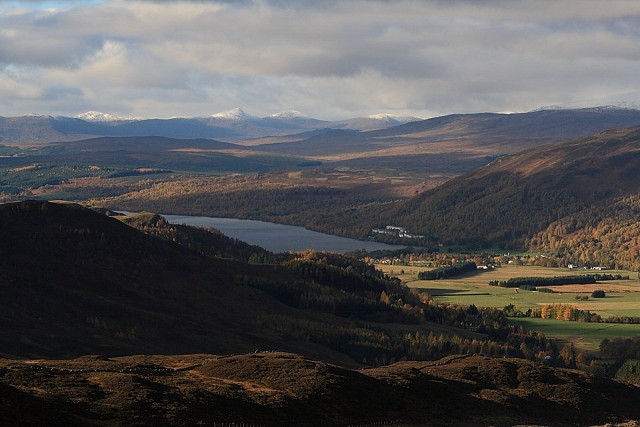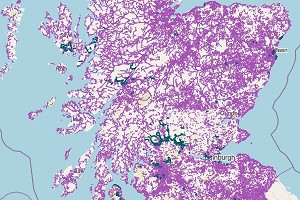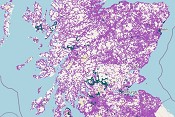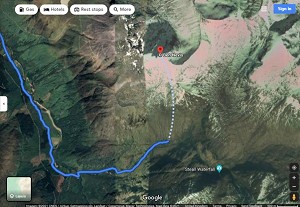
Following a public meeting last Thursday the final scoping report has been released for a plan to build a major wind farm on the northeast edge of Rannoch Moor. This could affect views from - among other hills - Schiehallion, the Drumochter munros, the southern Cairngorms National Park, a number of remote Corbetts and the Ben Alder massif - prime wild land in the heart of the central highlands.
It might even be visible from the A82 on the far side of Rannoch Moor.
The proposed Talladh-a-Bheithe Wind Farm is located around the minor summits Sron Bheag and Meall Ban in the empty hills north of Loch Rannoch and east of Loch Ericht, roughly 25km south of Dalwhinnie. It is right next to the Corbetts Beinn Mholach and Stob an Aonaich Mhoir. The development, which is being pursued by estate owners the van Well family, could comprise as many as 25 turbines each up to 125m high to the blade tip, plus ancillary infrastructure including temporary construction works, a crossing of the Perth-Inverness railway, and a grid connection to a new substation at Tummel Bridge/Errochty.
Three broad areas have been defined by the developer, but it is unclear in the report whether these three areas represent alternative options or if it is proposed to build turbines in them all.
However a look at this info leaflet provided by the estate sheds some light on their plans.
According to SNH Talladh-a-Beithe is a very sensitive site from the perspective of landscape and visual impacts, thanks primarily to its proximity to Loch Rannoch and Glen Lyon National Scenic Area and a Search Area for Wild Land, both of which are partially overlapped by the site.
In their respnse in the report, SNH say:
'Based on the information provided to date and the site constraints that we are currently aware of, if the developer is unable to demonstrate that the proposal will not have an extensive and significant detrimental impact on the landscape and visual resource, we may object to an application for consent submitted to Scottish Government'.
Though the proposed site lies outside their boundary the Cairngorms National Park Authority (CNPA) are less equivocal still.
'There could be significant landscape and visual effects arising from a windfarm development in this location on some areas within the Cairngorms National Park' they say, 'and in particular ...the plateau of the Gaick and the Forest of Dalnamein and Atholl and the Dalnacardoch and Dalnaspittal forests.'
'The area, though bisected by the A9 corridor, is remote, open and exposed, includes a number of Munros, and offers a high quality wildness experience.'
'...[T]he proposal is likely to affect the experience of Special Qualities within parts the Park and in particular the sense of wildness.'
'The landscape and visual effects on a number of key summits, especially the Drumochter munros and including Geal Charn, A'Mharconach, Sgairneach Mhor, Glas Meal Beag and A' Bhuidheanach could be significant.'
With other large wind farms close to the Cairngorms at various stages in the planning process the CNPA are concerned about the cumulative impact on the park, and the possibility that it will be slowly encircled by development:
'There are a number of wind farms in the planning process to the north and to the east of this site, but to date the south west part of the National Park and its setting, has been little affected by wind farm development outside the boundary' they say. 'The effect that this wind farm might have in contributing to the encircling of the National Park by wind farms should be examined in detail as part of a cumulative L&V assessment.'
The MCofS are scathing too.
'[W]ildness can be affected by developments outside the wildest area itself' they say in their contribution to the report.
'In particular, close scrutiny is required of the impact on wildness of the high areas across Loch Ericht, particularly the significant area of high ground of Ben Alder, Beinn Bheoil and the intervening ridge.'
'The MCofS considers that it is not possible to mitigate the effects of a wind farm development at this location to a level where the residual impacts are acceptable under national planning policy.'
It's now up to the van Wells whether or not to take their proposal forward to the planning application stage. If they do proceed, Talladh-a-Bheithe has the potential to turn into a major battle in the ongoing struggle between wild land conservation and all-out industrialisation. Bit by bit the development-friendly landowners and power companies seem to be taking over, but here at least conservationists are unlikely to roll over without a fight.
You can read the report here













Comments